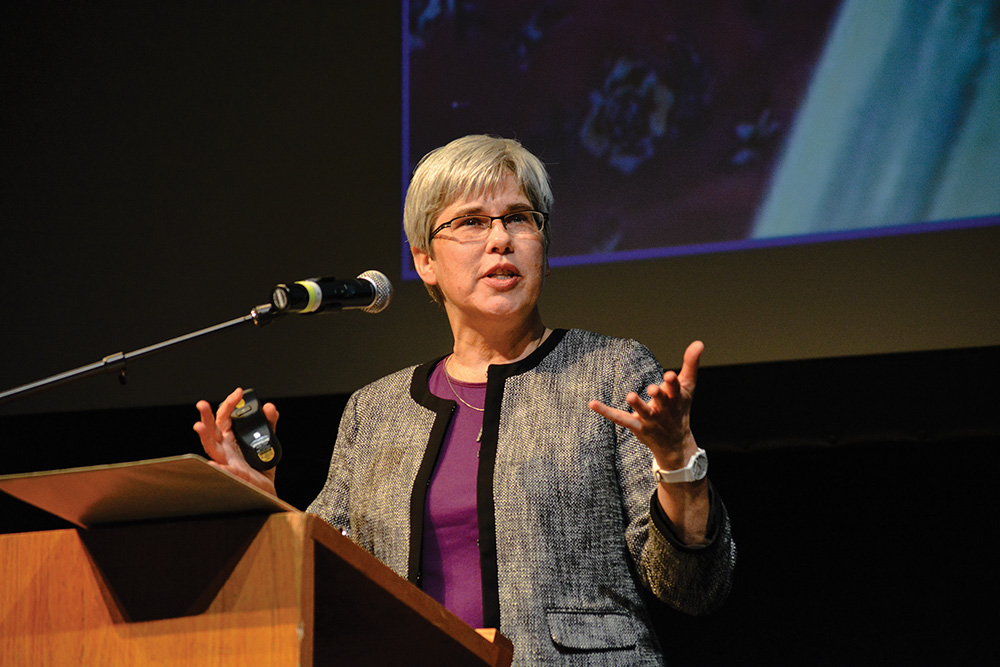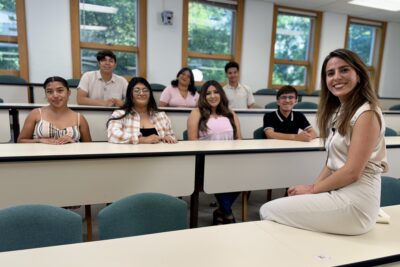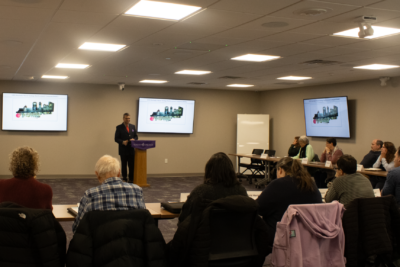Goshen College President Rebecca Stoltzfus released her strategic plan for the GC community in an all-faculty and staff meeting on Monday.
President Stoltzfus’ two-year strategic plan came from a number of different things: her “Soup Talks” where she invited around 130 students, administrative personnel and faculty to her house for dinner and discussion, “heat-mapping” of approximately 150 participants, a cabinet retreat, discussions with presidents from other institutions, and personal reflection and prayer.From the heat-mapping of the 150 participants, all of whom are faculty, staff or administrators, five statements were chosen to be “most vital to GC’s future”:
“Known for leadership in intercultural and international education, sustainability and social justice,” “Spirit of academic excellence,”
“Vibrant close-knit community, small class sizes and professors who know you by name,”
“International, intercultural, interdisciplinary and integrative teaching and learning,”
“A community of faith and learning built on five core values.”
A “deep-dive ethnographic” study was also conducted by Spark, a market research agency, which focused on a “diverse panel of top GC students.” It was concluded that these students value eight things:
“Ability to pursue a wide range of interests,”
“A small closely-knit community of support,”
“SST: A radical point of distinction,”
“They develop the sense that their presence matters,”
“Extraordinary personal attention from faculty,”
“The resonance of a peace and justice message,”
“Engaged and experiential curricula,”
“Personalized career support, however, is currently lacking.”
To strengthen and further pursue these values, President Stoltzfus released a new vision statement, which focuses on three words: Outstanding, joyful and purposeful.
“We believe an outstanding education is oriented in joy, growth and purpose,” the vision statement read. “Our extraordinarily student-centered faculty and staff integrate experience and global engagement with skills and knowledge from multiple disciplines to prepare students to thrive in life, leadership and service. The education we provide, rooted in the way of Jesus, transforms lives and communities. It is our moral commitment to enhance student access, full participation and equity in outcomes.”
From there, President Stoltzfus outlined four broad goals she hopes to achieve towards the new strategic vision.
The first was community. President Stoltzfus hopes to “engage across disciplines and with community, [encourage] generous inclusion and full participation and [foster a] fun and vibrant ethos.”
Next, President Stoltzfus hopes to develop the “student experience.” She plans on doing this through improving the “enrollment experience, academic support, co-curricular support, residence life innovations, [and] review and renovate internal communications to inform and connect students to the campus, from admit to alum.”
Academics is the next focus. President Stoltzfus plans to “strengthen experiential, off-campus and team-based learning, support humanities, strategically build on strength in sciences, [and] create an upper-level honors program that is aspirational and individualized for students.”
Finally, President Stoltzfus wants to refocus Goshen College’s purpose through a lense of life, leadership and service. To do so, the President would like to “revise [GC’s] mission statement, re-imagine campus governance at all levels to promote leadership and service, build and implement a new GC model for individualized career and leadership development, and build and integrate Graduate and Continuing Studies.”
As of right now, four institutional commitments have been made. The first is titled “operational effectiveness” and encompasses a handful of actions to achieve the desired outcome. For example, GC commits to performing evaluations on all leaders, using data and collected information to guide decision-making processes and making sure that departmental procedures match up with practices.
Another commitment is to create an environment that faculty and staff members are excited to work in. This will potentially mean “normalized” workloads to help prevent overworked staff.
The third commitment is to renovate facilities to help achieve goals. This could mean potentially creating “campus commons” where students, faculty and staff, and community members would gather.
Finally, Goshen College commits to stewardship. President Stoltzfus hopes to focus on ecological sustainability and take advantage of underutilized facilities.
Gilberto Perez, dean of students, said that it’s quite early to share President Stoltzfus’ strategic plan. President Stoltzfus agreed, saying that some goals may be overlooked if there isn’t energy behind it. However, it’s clear that Stoltzfus has support from faculty and staff on-campus to create a well-rounded institution.
“A strong component of the strategic vision will include inclusion and full participation,” Perez said. “A mechanism for increasing dialogue and addressing inequities within the college will be created. This mechanism will work to engage various parts of the college community on issues of race, gender, identification and religious diversity.”




